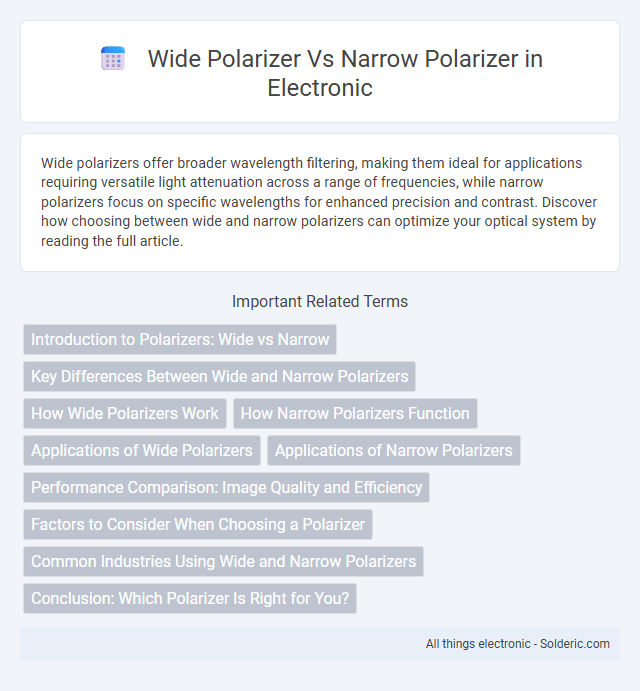Wide polarizers offer broader wavelength filtering, making them ideal for applications requiring versatile light attenuation across a range of frequencies, while narrow polarizers focus on specific wavelengths for enhanced precision and contrast. Discover how choosing between wide and narrow polarizers can optimize your optical system by reading the full article.
Comparison Table
| Feature | Wide Polarizer | Narrow Polarizer |
|---|---|---|
| Polarization Angle Range | Broad angular range (up to 180deg) | Limited narrow angular range (typically 10deg-30deg) |
| Use Case | General light filtering, outdoor photography, LCD displays | Precision optical instruments, scientific measurements |
| Light Transmission | Higher, due to broader range | Lower, due to selective filtering |
| Cost | Usually lower cost | Higher cost due to precision |
| Effectiveness | Effective for reducing glare and reflections broadly | More effective for polarized light accuracy and enhanced contrast |
| Applications | Photography, LCD screens, sunglasses | Microscopy, laser systems, scientific research |
Introduction to Polarizers: Wide vs Narrow
Wide polarizers provide broader wavelength coverage, making them ideal for applications requiring diverse light conditions and higher light throughput. Narrow polarizers offer precise wavelength selection with superior contrast and reduced stray light, enhancing performance in specialized optical systems such as spectroscopy and laser applications. Choosing between wide and narrow polarizers depends on the balance between spectral range and polarization purity for specific scientific or industrial uses.
Key Differences Between Wide and Narrow Polarizers
Wide polarizers allow a broader range of wavelengths to pass through, making them ideal for applications requiring expansive spectral coverage. Narrow polarizers filter light within a limited wavelength band, offering higher spectral precision and enhanced contrast in sensitive optical measurements. Understanding these key differences helps you select the appropriate polarizer based on your specific requirements for wavelength range and polarization accuracy.
How Wide Polarizers Work
Wide polarizers function by selectively filtering light waves over a broad angular range, allowing more light to pass through while reducing glare and reflections effectively. They employ advanced molecular alignment techniques that accommodate diverse light polarization angles, enhancing visibility and color contrast in various lighting conditions. Your choice of a wide polarizer ensures improved clarity and reduced eye strain, especially in dynamic outdoor environments.
How Narrow Polarizers Function
Narrow polarizers function by allowing only a very specific, tight range of light wave orientations to pass through, enhancing contrast and reducing glare more effectively than wide polarizers. This precise filtering is achieved by aligning microscopic polarizing molecules to block off-axis light waves, which improves image clarity in high-glare environments such as snowy landscapes or water surfaces. Your choice of a narrow polarizer can significantly enhance visual sharpness and color saturation, making it ideal for professional photography and scientific applications.
Applications of Wide Polarizers
Wide polarizers are essential in applications requiring broad-angle light management, such as augmented reality (AR) displays, wide field-of-view cameras, and advanced optical instruments. Their ability to maintain polarization over a wide range of incident angles enhances image clarity and reduces glare, making them ideal for automotive HUD systems and immersive virtual reality headsets. Using a wide polarizer in Your optical setup ensures consistent performance even under varying light conditions and viewing angles.
Applications of Narrow Polarizers
Narrow polarizers are essential in applications requiring precise control over light polarization, such as high-resolution microscopy, laser systems, and spectroscopy. Their ability to selectively filter specific polarization states enhances contrast and accuracy in imaging and measurement tasks. By integrating narrow polarizers, your optical systems can achieve greater sensitivity and performance in scientific and industrial uses.
Performance Comparison: Image Quality and Efficiency
Wide polarizers allow a broader range of light polarization angles to pass, resulting in higher light transmission and brighter images but potentially lower contrast and color saturation compared to narrow polarizers. Narrow polarizers filter light more selectively, enhancing image clarity, contrast, and color depth by blocking stray polarized light, yet they reduce overall brightness and efficiency. Performance trade-offs between wide and narrow polarizers hinge on balancing image quality with light efficiency, influencing their suitability for applications in photography, LCD displays, and optical instruments.
Factors to Consider When Choosing a Polarizer
Wide polarizers provide broader wavelength coverage, making them ideal for applications requiring consistent polarization across various light sources. Narrow polarizers offer higher extinction ratios and more precise control over specific wavelengths, crucial for laser-based or spectroscopic tasks. Your choice depends on factors such as spectral bandwidth requirements, extinction ratio, and the specific light source used in your optical system.
Common Industries Using Wide and Narrow Polarizers
Wide polarizers are commonly used in industries such as automotive and outdoor photography, where large-scale glare reduction and enhanced visibility are essential. Narrow polarizers find applications in precision sectors like electronic display manufacturing and scientific instrumentation, where controlling specific light wavelengths improves device performance. Your choice between wide and narrow polarizers depends on the industry-specific requirements for light filtration and polarization accuracy.
Conclusion: Which Polarizer Is Right for You?
Wide polarizers offer broader light filtration, reducing glare and enhancing color saturation in diverse lighting conditions, making them ideal for outdoor photography and general use. Narrow polarizers provide more precise control over polarized light, improving contrast and clarity in specific scenes like reflections on water or glass. Your choice depends on whether you need versatile performance with wide polarizers or targeted effect with narrow polarizers for capturing detailed imagery.
Wide Polarizer vs Narrow Polarizer Infographic

 solderic.com
solderic.com